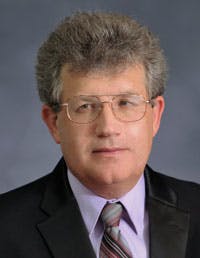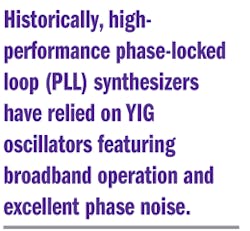This file type includes high resolution graphics and schematics when applicable.
Dr. Alexander Chenakin, vice president, advanced technologies at Micro Lambda Wireless, Inc., is responsible for overseeing the development of advanced signal-generator products. Chenakin is well recognized in the field of frequency synthesis. In 2009, he received the ARMMS RF & Microwave Society’s Best Contribution award for his work on fast-switching frequency synthesizers. His professional achievements have been widely presented in trade publications and international conferences. Chenakin has written more than 40 technical articles, holds two U.S. patents, and is the author of Frequency Synthesizers: Concept to Product. He is a senior IEEE member and has been an invited speaker for several IEEE-sponsored events.
CD: This is your second stint with Micro Lambda Wireless. How has the industry changed since the first time you were with the company?
AC: Micro Lambda Wireless offers a variety of components (such as YIG oscillators, filters, and frequency synthesizers) for complex microwave subsystems and instruments. In the past, microwave instruments were built using individual connectorized modules connected with coaxial cables. The designer could easily isolate and refine individual blocks to make them perfect. These days, such complex assemblies have to be made on a common printed-circuit-board (PCB) using tiny surface-mount parts.
For example, we have a synthesizer (that will be announced soon) that measures only 2.5 × 2.5 × 0.65 in., while showing quite remarkable noise characteristics (-125 dBc/Hz at 8 GHz output, 100 kHz offset). A great effort is required to minimize interactions between individual devices sitting on the same board in such a crowded space. Furthermore, many parts are reused to accomplish different functions, which are distributed through the whole assembly. The net result is a significant increase in "design density," meaning both component count and functionality per square inch. This seems to be a "must" approach these days.
CD: When it comes to frequency synthesizers, what are some of the most demanding requirements you see today?
AC: As a general trend, the modern equipment tends to be faster, smaller, and less expensive. For frequency synthesizers, they say "less is more," meaning lower phase noise, lower spurs, lower power consumption, and lower cost. To complete the picture, low settling time—or in other words, fast switching speed—becomes increasingly valuable as dictated by the ongoing increase of the data rates of modern microwave systems. These characteristics are easily achievable separately. However, they can represent a certain challenge if they have to be met simultaneously; that’s normally the case.
Besides demanding performance characteristics, modern synthesizers are expected to provide extended functionality such as amplitude control or various modulation formats. A very desirable function is in-phase/quadrature (I/Q) vector modulation. In the past, high-quality, test-and-measurement (T&M) grade IQ signals were only available in high-end bench-top signal generator instruments. Today, due to the rapid development of highly integrated ICs, this function can be brought to the synthesizer module level. A high-performance I/Q synthesizer is on the list of our new developments.
CD: What are some of the most notable technology advancements of the last five or 10 years with regard to oscillators and frequency synthesizers?
AC: There are a number of outstanding products in this field acknowledged by the industry, and described in detail in Microwaves & RF's 50th anniversary issue featuring the most notable advancements and "people who made it happen." Not trying to rank any specific developments, I would emphasize device miniaturization as a general trend that opens new horizons in the development of complex microwave solutions.
AC: Historically, high-performance phase-locked loop (PLL) synthesizers have relied on YIG oscillators featuring broadband operation and excellent phase noise. YIG oscillators also offer very linear and repeatable tuning characteristics that simplify the synthesizer coarse tuning in multi-loop schemes. These unique features provided the domination of the YIG-based designs in high-end applications, such as test-and-measurement signal generators. The disadvantages of YIG oscillators include high power consumption, large size, and relatively slow tuning speed.
Alternatively, VCOs tune faster—typically in the microsecond range. In addition, the size, power consumption, and cost of VCOs are generally lower compared to YIG devices. However, the noise performance of a VCO itself is considerably worse. This puts a lot of pressure on synthesizer designers to suppress VCO noise using system-level solutions, such as multi-loop, wideband PLL architectures. Nevertheless, very low phase noise (T&M grade) is achievable in VCO-based synthesizers, too. Micro Lambda actively explores both technologies, as well as new innovative system-level solutions, to deliver the fastest tuning speed and lowest phase noise compared to the industry standards.
CD: With the move to higher frequencies (i.e., 5G), what additional challenges will that present?
AC: Millimeter-wave frequencies hold the strongest potential to power 5G wireless networks. Historically, millimeter-wave components were built using die devices and chip-and-wire technology. Expensive equipment, tight tolerances, and extensive tuning were key words in the millimeter-wave designer’s vocabulary. Due to high technology costs and limited integration capabilities, such components have been mostly restricted to special applications.
However, the recent demand of low-cost, mass-production devices is drastically changing the millimeter-wave realm. Today, highly-integrated surface-mount ICs are available up to high millimeter-wave frequencies, therefore allowing complex components and subsystems to be built using low-cost PCB technologies. A frequency synthesizer—as a part of virtually any microwave or millimeter-wave subsystem—is a part of the game. We are focusing on the development of innovative millimeter-wave synthesizers up to 110 GHz to bring truly high-performance, yet affordable alternatives to traditional solutions.
CD: Lastly, do you see possibilities to further improve the performance of oscillators and synthesizers in the future?
AC: Absolutely. What is a frequency synthesizer? It is a "black box" containing some circuitry that translates one (or more) input frequency—called a reference—to a number of output frequencies with desired characteristics. Thus, the input reference oscillator sets the initial frequency quality standard or expectations.
Today’s commercial oven-controlled crystal oscillators (OCXOs) easily achieve phase noise performance of −176 dBc/Hz (or better) at 10 kHz offset and 100 MHz output. This can potentially translate to performance of −136 dBc/Hz at 10 GHz—assuming the synthesizer circuitry is "ideal." Though nothing is ideal, all current developments are chasing for such an ideality and are quite close. Direct analog and direct digital techniques have a big potential here.
However, a major breakthrough is expected by using a reference with other physical principles or materials, for example, using optoelectronic methods or sapphire resonators. Phase noise of around −170 dBc/Hz at 10 kHz offset at 10 GHz output (not 100 MHz!) for a sapphire-resonator-based oscillator has been reported. These quality expectations will dramatically change conceptual approaches for building new synthesizers or even the whole way of thinking about this problem. What performance can be eventually achieved? Only the future will tell. A lot of amazing developments are expected to occur over the next decades.
This file type includes high resolution graphics and schematics when applicable.




